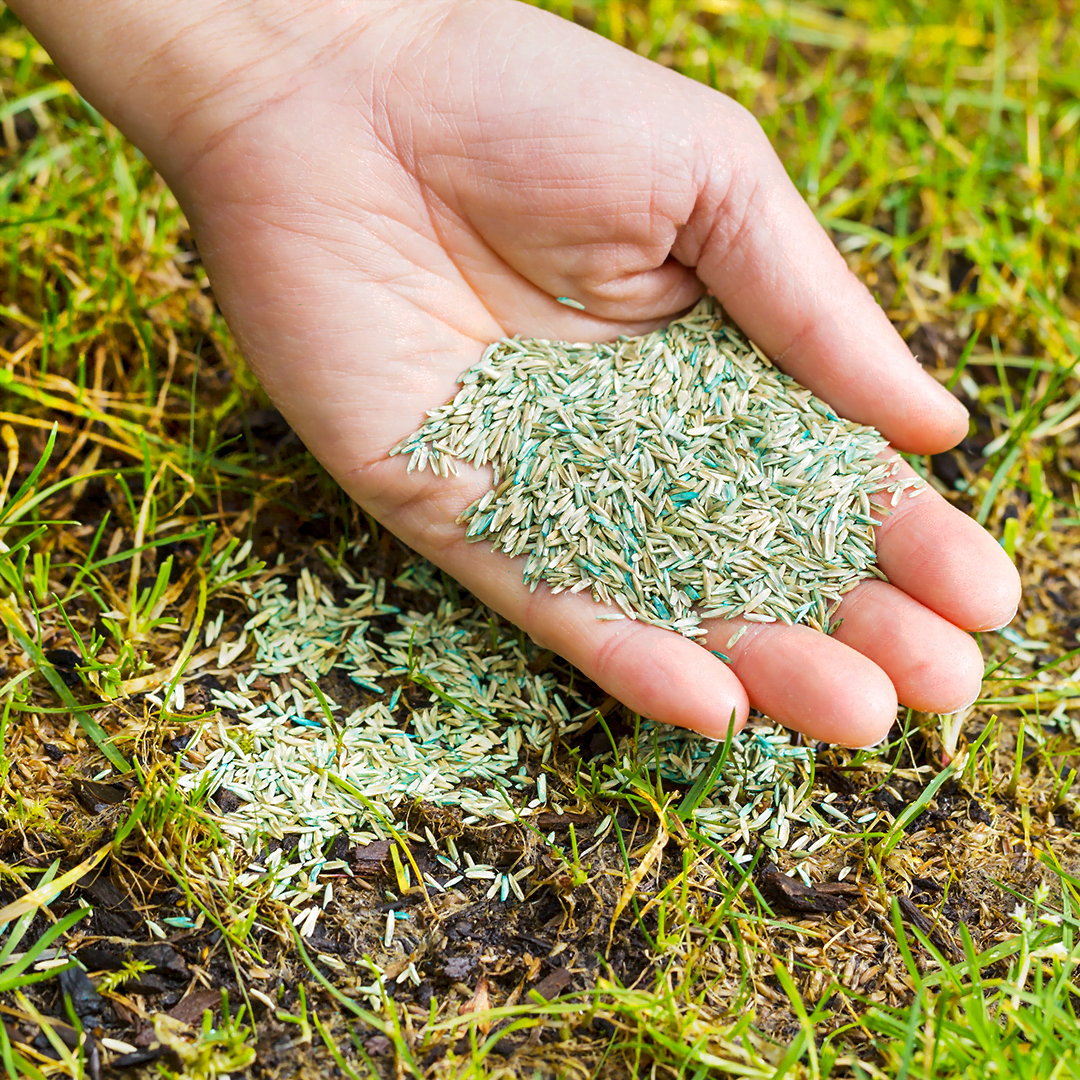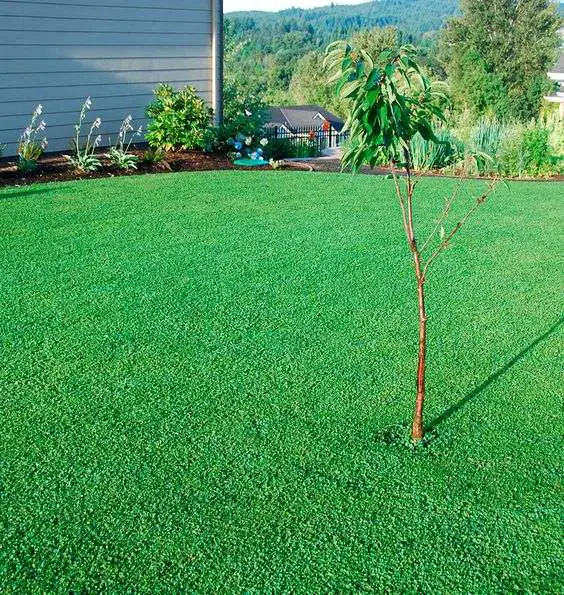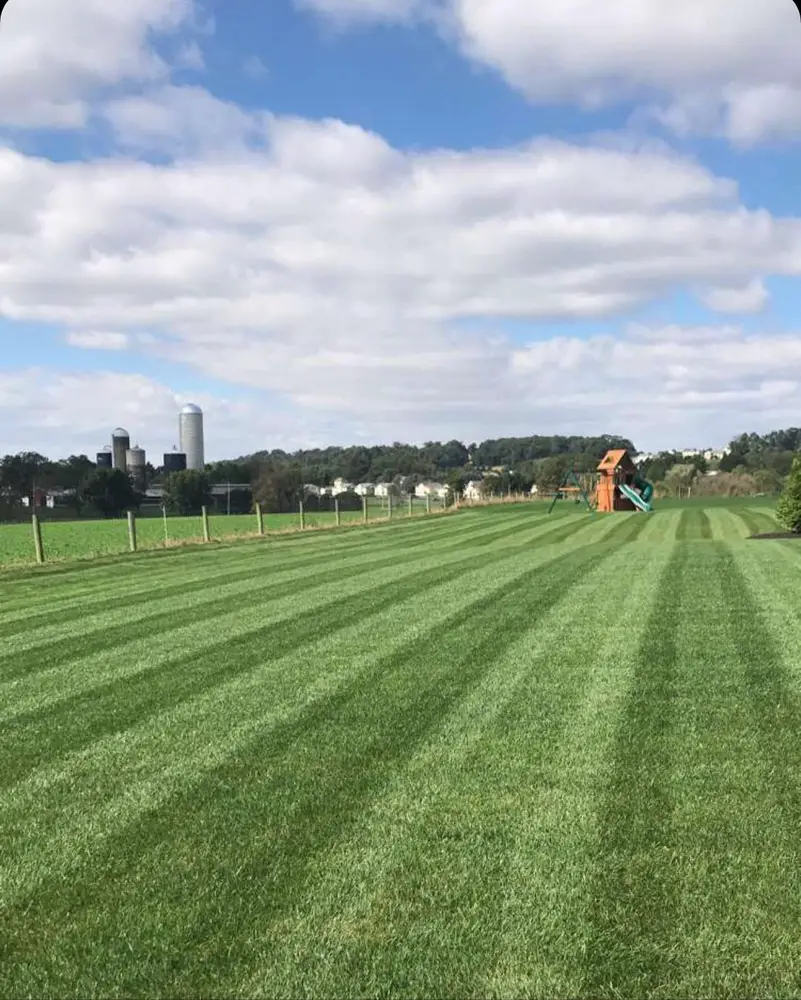Why Should I Overseed My Lawn
One of the main benefits of overseeding a lawn is that it revitalizes a thinning lawn without having to start from scratch and reseed the lawn. Over time, even the best lawns can begin to lose the vigor they once had. Factors such as excess traffic, too much shade, weather conditions, and disease can take a toll on your lawns appearance and cause the grass to thin. Overseeding can help to thicken those thinning areas by filling them in with new grass seed.
Overseeding also increases your lawns ability to resist weeds and disease. Thinning, worn-out lawns create ideal conditions for weeds to grow because there is plenty of space available. Overseeding is a quick and easy way to crowd out weeds by thickening the existing lawn and denying space, light, and nutrients needed for weeds to grow. Remember, the best way to keep weeds from taking over is to have a healthy, dense lawn.
Broadcast Seed With A Cyclone Or Drop
This second method of overseeding is also effective, if youre unable to use a slit-seeder. Aerate several times before broadcasting seed aeration holes should be spaced not more than 2-3 inches apart. Use core-type aerating tines that remove soil plugs for better seed-to-soil contact. After overseeding, give the area a heavy watering right away to wash seed into the aeration holes and help break up the aeration cores on the surface.
One challenge with broadcast seeding is that much of the seed gets hung up in the thatch layer and does not get into the soil where it can germinate. Be sure to use grasses that have a creeping growth method to ensure even growth grass types that do not spread will grow in the aeration holes only and give the turf a clump or spotted look. Remember broadcast seeding requires more grass seed and the germination rate is not as high as with slit-seeding.
When To Overseed Your Lawn In Fall
The fall months are the best time to overseed your lawn to bolster your backyard ideas, explains Rachel Crow, garden editor for Homes & Gardens. Between late August and early October, the grass is typically at its thinnest, meaning grass seed can more easily reach the soil and germinate before the harsher, colder winter months.
It is a good idea to choose a day with mild weather, preferably after rainfall, so your lawn is moist but not muddy. Selecting a day with little wind will also reduce the chance of your grass seed being blown away.
The still-warm earth and natural rainfall that tends to arrive in September will help to nourish and stimulate the newly sown seed, as well as reduce the time youll have to spend watering or trying to beat any hosepipe bans, says Guy Jenkins consumer manager for Johnsons Lawn Seed. By waiting until later in the year you will avoid the summer droughts which spell death for tender young seedlings that havent managed to reach deeper groundwater.
Another benefit of September is that any weeds which find their way into your newly sown lawn will have a chance to germinate and can be easily removed before their own roots have a chance to develop. In the meantime, your grass can grow strong roots in later autumn and will be in the best possible shape to withstand early droughts come the following spring or more serious summer droughts that might be on the cards, Guy adds.
You May Like: Do I Need To Dethatch My Lawn
Overseeding Your Tired Grass Can Give It A Much
Summer can take a lot out of your lawn. Hot, dry conditions and heavy shade cause the most grass damage. Outbreaks of disease and insect activity can make matters worse. And if you have kids or pets, your lawn may be worn to shreds, exposing the soil beneath. Not good!
General yard maintenance helps. But like other home assets, such as your exterior walls and kitchen appliances, the amount of TLC you give your lawn can go a long way. Overseeding after a summers worth of stress and abuse will pay dividends, keeping your lawn looking and performing its best once the snow melts next spring.
Your lawn cant dodge general wear and tear caused by Mother Nature. And the way you and your family use your lawn can add to your maintenance woes. By seasons end, your lawn is tired and showing signs of stress.
On This Page
Calendar: Cultural Practices And Related Activities

This chart summarizes when turf management practices are most effective as to timing of fertilization, mowing, irrigation, liming, soil testing, cultivation, and planting activities. These dates are only guidelines and are NOT intended to indicate absolute start and end dates for all regions of Massachusetts.
| Practice |
|---|
Also Check: How To Spot Treat Clover In Lawn
When Should You Overseed Your Lawn In The Fall
Overseeding is best done in the early fall, between mid August and early October so theres still time to repair your yard. The main event you want to avoid is the first frost as any seedlings will perish.
The type of grass seed youre sewing can make a difference to the best soil conditions as well cool-season grass, such as Kentucky bluegrass, prefers soil temperatures below 65°F, while warm-season grass, like Bermuda grass, prefers temperatures of at least 65°F.
You can use a basic soil thermometer to check the conditions, such as the Urban Worm Soil Thermometer ). Because of this, you are better-off overseeding warm-season grasses earlier in the year, from late spring to early summer.
While you might think what remains of the heat of summer will make for ideal growing conditions, dont overseed at this time. Grass seeds are fragile and actually prefer moist conditions and lower temperatures to germinate. So, if youre still facing the final stages of a drought, hold off on overseeding. Because of the moisture preference, overseeding is also best done a day or two after rainfall, but bear in mind you want the soil moist, not saturated.
There should be fewer weeds at this time of year , but youll want to remove any that remain before overseeding. The roots of weeds are strong and dominating these will hog the nutrients in the soil, which will stunt the growth of your grass seedlings.
Correct Existing Lawn Problems
For troubles beyond normal thinning, test your soil and make corrections before overseeding. Follow test recommendations for using soil amendments and repairing bare lawn spots. If needed, take time to dethatch and core aerate compacted lawns so air, moisture and seed can get to the soil. Pennington One Step Complete products combine premium seed with a stabilized-release fertilizer and wood mulch to simplify lawn repairs.
You May Like: How To Get Rid Of Fescue In Lawn
Prepare The Area To Overseed Or Reseed Your Lawn
There are a few key things you can do in preparation for overseeding or reseeding your lawn:
- Remove any debris from the area, including leaves, branches, and stones.
- Rake the area to loosen the soil and create a smooth surface.
- Apply a layer of compost or manure to the area and rake it in.
- If youre overseeding, spread the seed evenly over the area and rake it in. Dig up the entire lawn and remove any old grass or weeds if youre reseeding. Sprinkle the new seed over the place and rake it in well.
- Water the area well until the soil is moistened completely.
- Keep the area wet until the new grass has grown in completely usually about two weeks.
How To Overseed A Lawn: In The Fall Or Any Other Time Of Year
Overseeding a lawn in the fall is one of the best things you can do for the health and thickness of your turf. The fall is the optimal time of year to grow grass from seed and its the best time of the year to push new growth in your existing grass.
The steps outlined below are going to work for an overseeding project at any point of the growing season, Spring, Summer, or Fall but if you can wait until late August to late September then your chances for success are going to be greatly increased.
With that being said overseeding a lawn is fairly straight forward.
To properly overseed a lawn you want to spread grass seed evenly across your lawn space ensuring you get seed-to-soil contact. Apply starter fertilizer and cover with peat moss to retain moisture and protect the seed from wind and animals. Lightly watering the seed a few times a day is all that is needed to get it to germinate and depending on the grass type this can happen in less than 1-week.
However there are many optional steps that you can take to improve germination rates, improve even coverage, encourage deeper rooting, and stop animals from disturbing the seed bed.
Id like to cover those optional steps and provide some extra detail on how I overseed for nearly perfect germinationbut first Id like to show yo a video I made on this topic which Ive embedded below.
You May Like: Does Aarons Rent Lawn Mowers
How To Overseed Your Lawn In Fall And When To Do It
Looking to overseed your lawn before winter hits? Heres what you need to know
Its been a difficult summer for lawn care to say the least. The endless heat waves have left many of us questioning how much you should water your lawn, and if you couldnt keep on top of demand, the result is dead grass everywhere and crabgrass galore. Many lawns have now been left with ugly bald patches of soil scattered as far as the eye can see.
While you might think learning how to plant grass seed is the answer, overseeding may be the better method if youre dealing with patches of exposed soil. The fall provides ideal conditions for overseeding, however with winter approaching, your window is quickly closing and you need to act fast if you want to get those patches covered and growing in time to survive. Heres what you need to know about overseeding your lawn in the fall.
How Much Grass Seed
When youve decided which lawn seed to use, the instructions should tell you the rate at which it needs to be applied. Quite often the over seeding rate is lower than the rate for starting a new lawn though sometimes adding more, particularly if rye grass is included, will speed recovery. However, if you are trying to improve your lawn by changing the type of seed then adding more will cause more of a change.
Do NOT automatically assume more is better! Ive seen patch repairs done where you cant see the soil for grass seed. This will cause extremely dense growth that will stick out like a sore thumb. If in doubt stick to about 10 to 20 seeds per square inch.
The next page will cover all the variables for seeding rates.
Recommended Reading: How Much Do I Need To Water My Lawn
Don’t Forget To Water
According to Mayer, “watering is one of the most important aspects of successful overseeding.” After applying seed, a heavy watering is in order, after which a daily watering should be performed until seeds germinate, which can take up to two weeks. Once germination has occurred, continue to water thoroughly every few days. “It’s important to keep the soil bed moist during the germination process or seed failure could be the end result,” says Mayer, adding that it’s also important to avoid heavy activity, such as mowing, on the delicate area.
What Should Be Done After Overseeding To Ensure Good Seed Germination

After seeding, keep the seedbed moist with frequent, light applications of water. Its often necessary to water once or twice a day. Continue to mow the lawn at a height of 1.5 to 2 inches. Mow the lawn frequently to reduce the competition from the established turfgrass. Gradually increase the mowing height when beginning to mow the new seedlings.
You May Like: How Much Is Lawn Care Insurance
Should I Fertilize Before Or After Overseeding
If your lawn has not been fertilized recently, it might be a good idea to lay a lawn starter fertilizer before overseeding. Adding fertilizer to your lawn will encourage germination by providing the right nutrients for initial growth. You will want to avoid standard fertilizer for established grass as this rarely has the nutrients needed for root development.
Select A Quality Grass Seed Product
Better seed yields better lawns. Always use grasses recommended for your regional climate and choose top-quality grass seed you can depend on. Pennington Smart Seed products provide premium grass seed appropriate for sun, shade or high-traffic areas in lawns in northern or southern regions. Three-in-one Pennington Lawn Booster combines superior Smart Seed varieties with premium-grade fertilizer and soil enhancer.
Don’t Miss: Why Is My Lawn Yellow In Spots
How Do I Get Rid Of Old Grass And Plant New
You can leave the dead grass to compost in the yard or rake and remove it to prepare the soil for new sod. Sheet composting is another method for removing old grass for new sod. Again, mow the grass as short as possible and then cover the lawn with cardboard or newspaper, ensuring that no sunlight can reach the grass.
How To Overseed A Lawn
This article was co-authored by Keith Souza. Keith Souza is a Home Improvement Specialist and the Owner of Vaulted Hammer Handyman Services. He specializes in home repair, home automation, and yard maintenance. Keith holds an AAS in Electronics Technology from Heald College.There are 7 references cited in this article, which can be found at the bottom of the page.wikiHow marks an article as reader-approved once it receives enough positive feedback. In this case, 100% of readers who voted found the article helpful, earning it our reader-approved status. This article has been viewed 718,311 times.
Overseeding is one of the most important tasks involved in growing a healthy, lush lawn. While fertilizing your lawn is important, grass plants slow down their rates of reproduction after a few years. Over time, lawns that have not been overseeded will grow thin and unhealthy, making it much easier for weeds to overtake the lawn. Overseeding can be time-consuming if you have a large lawn, but it is not difficult, and the results are well worth it the effort.
Also Check: How To Repair Lawn Furniture
So Which Grass Seed Should You Choose
Grass seed generally comes in four categories
I recently wrote a whole grass seed buyers guide. It takes the guesswork out of which grass seed to buy because I tell you which is the best for each circumstance.
It tells you, if your lawn sits under a lot of shade, choose this grass seed. If you want a good looking lawn thatll cope with the kids playing on it, choose this one.
How And When To Overseed Your Lawn
Are you an avid gardener taking the best possible care of your lawn – watering, weeding, mowing, fertilizing and everything else needed for it to flourish? Do you still have issues with your lawn looking worn out, thin and unhealthy despite that? Dont worry, this is something that happens more often than not and we have just the solution you need.
Overseeding is the process of sowing new seed into an existing lawn. This method is used by professional gardeners and knowledgeable garden enthusiasts and will turn your tired lawn into a fresh and vibrant paradise. Overseeding could take some time and effort, especially if you have a bigger lawn, however, its very useful, produces great results and is environmentally friendly as it reduces the need to use chemicals to support your lawn. Read on if you want to learn how to overseed the right way.
Recommended Reading: How To Get Rid Of Ants In Your Lawn
What Type Of Grass Seed Is Best
Your choice of grass is generally determined by your areas climate. Cool-season grasses, such as Kentucky Bluegrass, Perennial Ryegrass, Bentgrass and the Fine Fescues, are used primarily in western, northern and eastern areas of the United States. They tolerate moderate summertime temperatures but will also survive severe cold associated with northern winter conditions.
Warm-season grasses, such as Bermudagrass, Centipedegrass and Bahiagrass, are used in the south, southeast, and southwest United States. Theyll withstand extreme heat, but are unable to tolerate sustained temperatures well below freezing. Tall Fescues are used extensively in the midsouth and west regions and with the advent of new turf-type Tall Fescues, their use is expanding into other geographic areas as well. For detailed recommendations, contact your lawn care professional or county extension agent.
Do you need to start over?Proper overseeding can renovate a lawn if it has at least 50% or more healthy turf. However, if your lawn has less than 50% healthy turf, it may be better to kill out the old turf, weeds, etc., and reseed the entire lawn.
Change A Lawns Appearance Or Tolerance

Overseeding allows you to gradually change the appearance of your lawn or increase its tolerance in different ways.
For example, lets say you have an ornamental lawn that doesnt cope very well with the kids and pets running around on it. Overseeding with a mix of harder wearing grass types will create the best of both worlds a good looking lawn thatll cope with the stresses your family puts on it.
On the other hand, you might have shady areas on your lawn where the grass is patchy and sparse. Overseeding with a grass blend that grows well in shady areas will improve both the look and tolerance of your lawn in those areas.
Also Check: Does Lowes Sell Lawn Mower Tires